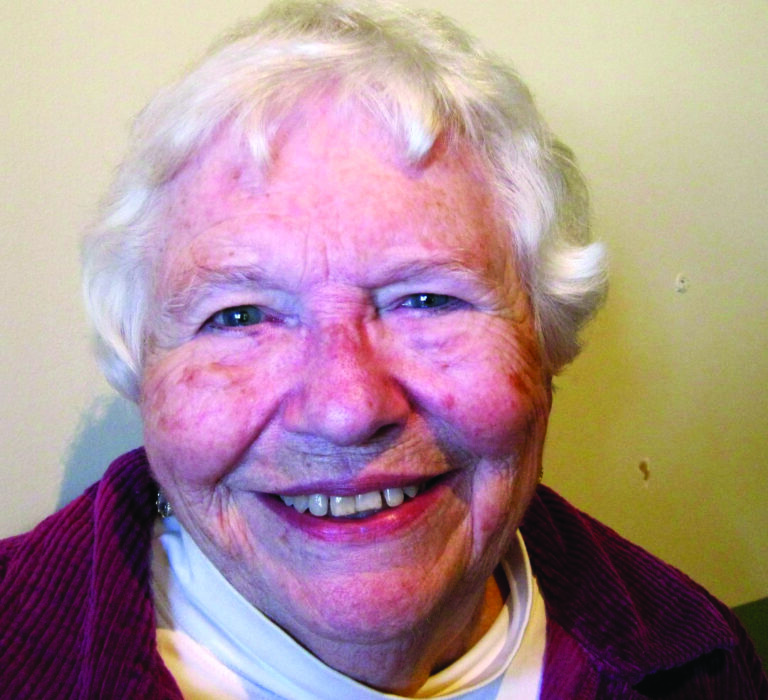
By Diane Walder
Northside News
Northside resident Mary Pike is a remarkable woman and, at age 85, a very busy one. Her life had been fairly typical — family and work — but when her husband’s behavior became atypical, her life changed and took her a new direction.
Mary ended a nearly 20-year career in the UW Department of Pediatrics when her husband began showing signs of Alzheimer’s disease. “At that time we didn’t know how the disease expressed itself and there wasn’t as much information available as there is now,” said Mary. “We noticed small things in the beginning. We drove to Philadelphia and Bob’s driving was erratic. While staying with friends in Finland, Bob walked out the door to mail a letter and got lost. He was lucky he found someone who spoke English to help him get back. Soon his cognitive abilities diminished.”
Caregivers of older people and those with disabilities generally have a rough road. Stress, feelings of inadequacy and other physical and emotional effects on caregivers can take a serious toll; double that for caregivers of people with dementia. “You’re dealt a hand of cards and you deal with that the best you can,” she said.
So Mary took things as they came and remained calm as her husband’s disease progressed. She capably cared for him and intuitively applied ingenious strategies to cope with his increasing symptoms. “My husband grew up in Minnesota. He repeatedly asked me to drive him back to the house he lived in as a child. He just wanted to see it. Finally, one day I put him in the car and we drove around our Middleton neighborhood, looking at the pond and the ducks, and drove home. That seemed to satisfy him,” said Mary.
Mary’s experience motivated her to become involved with the Alzheimer’s Alliance, serving on its public policy committee and board of directors.
As time passed Bob began to have seizures. One day he fell, and after four years of caring for Bob at home, Mary knew she could no longer do it herself. She placed him in a Community Based Residential Facility (CBRF). Making this decision is one of the hardest parts of caregiving, and the assumption is that you can breathe a sigh of relief; you believe your life partner will be safe and well taken care of. Maybe. And maybe not.
At the CBRF Bob fell and broke his hip, which necessitated a move to a nursing home, where he lived until his death eight years later. “Bob fell because the aide did not follow the care plan. Employees at care facilities need proper training so they know not only how to properly care for the residents, but also understand how to communicate with them and help them through that period in their lives. If they haven’t had proper training, it exacerbates the resident’s condition,” said Mary.
When Bob was no longer at home, Mary got busy. She became a member of the legislative/advocacy committee of Dane County’s Area Agency on Aging (AAA). She got involved with the Advancing Excellence Program, which sets improvement goals for nursing homes. She was invited to join the Wisconsin Person-Directed Care Coalition, which helps facilities and caregivers learn how to honor the care receiver’s preferences and choices.
One day she saw a newspaper ad seeking volunteers willing to be “the eyes and ears” of the residents in nursing homes and make weekly visits to them to ensure rules are followed and residents are being treated with respect. “I’d spent 10 years going to CBRFs and nursing homes,” said Mary. “I knew what to look for.”
So Mary took the training to become a volunteer ombudsman. A program of the Wisconsin State Board on Aging and Long-Term Care, volunteer ombudsmen are trained to observe and track the conditions of the facility, work with residents and their family members to communicate concerns and complaints, and then report to the facility’s administrator. The volunteers develop relationships with the residents so they feel comfortable confiding their problems to them.
“Residents have rights and deserve to get their needs handled in a timely manner,” said Mary. “No one should have to wait more than five minutes for assistance when they push the help button — and that help button should always be accessible. Residents should be able to express and receive their food preferences. Residents look forward to seeing us and having someone to visit with. Some residents seldom have visitors. It gives us a chance to see that they’re being treated with respect and dignity. Our conversations with residents are confidential and it’s only with their permission that we can express their concerns to the administrator.”
Mary has four children, nine grandchildren and 10 great-grandchildren scattered throughout the country. When she’s not advocating, she reads, takes walks and practices Tai Chi. She continues her work on the AAA’s legislative/advocacy committee, the Alzheimer’s Alliance, and as a board member for the Dane County Aging and Disability Resource Center.
“I have found that being able to advocate for nursing home residents and older people is rewarding, and I encourage others to do the same. Advocacy is important. Lawmakers need to be made aware of the impact their decisions have on the quality of life of older people and especially of those in nursing homes, whose voices are often reduced to whispers. As a volunteer ombudsman, I can be their voice,” Mary stated.
You, too, can stand up for the rights of nursing home residents. For more information about the Volunteer Ombudsman program, contact Julia Pierstorff at 246-7004 or email Julia.Pierstorff@wisconsin.gov.